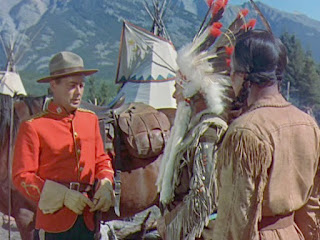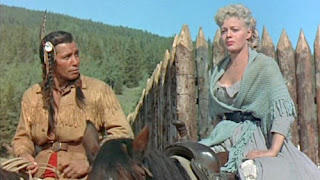Directed by Raoul Walsh; produced by Aaron Rosenberg
It’s 1877, and a Northwest Mounted Police inspector (Alan Ladd) in western Canada has his hands full. His new superior (Robert Douglas) is inexperienced but arrogant; the lone survivor (Shelley Winters) of a massacre doesn’t want to be rescued; an American lawman (Hugh O’Brian) is giving trouble, and there may be an Indian uprising in the offing.
The first thing one might notice about this movie is the poster, which depicts the stars against a background of huge mountains. To those who know the province of the film’s title, showing mountains in connection with it is rather like describing the vast, sweeping plains of Switzerland, or the burning deserts of Delaware. The script manages to avoid actual irony by setting the story at the headwaters of the North Saskatchewan River, which are indeed in the Rocky Mountains. But its geography is askew in other ways. It mentions Forts Saskatchewan and Walsh, but neither of these real places are anywhere near the mountains. As well, Winters is first encountered trying to get to Battleford from Fort Macleod. That route would in reality take one away from the Rockies, not keep one in them.
Why Saskatchewan was chosen as the title, I don’t know. The name may have sounded exotic to the American producers. I am reminded of the scene in Rogue Male in which the protagonist confides to his uncle that he must go into hiding. The uncle advocates fleeing abroad, perhaps to Saskatchewan, which he pronounces very deliberately. Then he adds, “Er, where is…Sas-kat-chew-an?”
However, the film is historically at fault, as well. The story centres on a large body of Sioux coming into Canada after their victory over the United States at the Battle of the Little Big Horn. Filled with confidence, they seek to incite the native Cree to rebel against Canada. The attempts of Ladd to keep the peace, and deal with the results, form the bulk of the story. In fact, the Sioux came to Canada to settle down in peace, though they eventually returned to the U.S.
All of this I can forgive in the right movie. I am not so pedantic as to insist on rigid accuracy if the film is a good one. But Saskatchewan is not really that good. Ladd’s character is a standard type: raised locally (how he ended up in the NWMP when all of its initial members came from elsewhere is not explained), he is knowledgeable and experienced; his new superior is a stiff know-it-all. There’s the Indian blood-brother (Jay Silverheels), the tough girl on the run, ambushes, gun-fights. While it is all competently done, it has also been competently done before, and better. The writing is unmemorable, the characters two-dimensional. And did no writer ever hear of infection from bullet wounds? One Mountie runs to join his fellows for the climactic battle just days after being shot in the abdomen.
While Saskatchewan certainly shows Canada in a good light, it does not reflect as well upon its own qualities. If viewers want entertainment with a Mountie in it, perhaps they could watch an old episode of Due South instead.






Or Dudley Do-Right, which was probably more realistic than this movie.
ReplyDeleteI try not to be too pedantic about such things, but it's my experience that if historical books or movies can't get basic facts straight, they're usually pretty worthless entertainment as well.
Ah, but Alan Ladd looks FINE in a Mountie uni! Whoo!
ReplyDeleteMy first thought, there was a movie called Saskatchewan? I'm pretty sure I'll avoid this one as I'd just get annoyed with the geographical and historical errors. I guess in those times there was no concern that people would point them out...pre-Twitter!
ReplyDeleteNever~The~Less..Still a good movie to watch on
ReplyDeletea rainy Sunday afternoon..! :).
Alan Ladd, my Mums..favourite of all time, if
Alan Ladd was in a film..she'd watch it..! :).
Shelly Winters, one of my favourite ladies,
she always had that 'facial' look, for comedy,
and serious rolls..And of course there's Jay
Silverheels, who was a Mohawk actor and athlete.
He was well known for his role as Tonto, the
faithful Native American companion of the Lone Ranger
in the long-running American western television series
The Lone Ranger...Saturday afternoons..5 o'clock..BBC1,
Born in Branford..Canada..!
AND..of course his famous term..Kemosabe a term of
endearment used by him in the TV series The Lone Ranger! :).
We are put off by the magically healing wounds and dont think they add to a movie. Thanks Willie for that background. We like Shelly Winters in many of her roles.
ReplyDelete